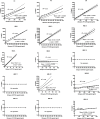Altered Toll-Like Receptor-4 Response to Lipopolysaccharides in Infants Exposed to HIV-1 and Its Preventive Therapy
- PMID: 29491865
- PMCID: PMC5817973
- DOI: 10.3389/fimmu.2018.00222
Altered Toll-Like Receptor-4 Response to Lipopolysaccharides in Infants Exposed to HIV-1 and Its Preventive Therapy
Abstract
Pathogen sensing and recognition through pattern recognition receptors, and subsequent production of pro-inflammatory cytokines, is the cornerstone of the innate immune system. Despite the fact that HIV-exposed uninfected (HEU) infants are prone to serious bacterial infections, no study has focused on the functionality of their bacteria recognition system. This is the first study to investigate baseline levels of three critically important immune response molecules in this population: complement component (C)-3, toll-like receptor (TLR)-4, and C-reactive protein (CRP). We enrolled 16 HEU and 6 HIV-unexposed (HU) infants. TLR4 function was investigated by stimulating whole blood with increasing concentrations of TLR4-agonist ultrapure lipopolysaccharides. TLR4/TLR4-agonist dose response were assessed by measuring IL-6 secretion. Complement C3 and CRP were measured by photo spectrometry. Data showed no significant differences in baseline concentration of CRP between HEU and HU infants. Complement C3 was significantly higher in HEU infants than HU infants. TLR4 anergy was observed in 7 of 12 HEU infants, whereas the rest of HEU infants (n = 4) and the control HU infants tested (n = 3) showed responsive TLR4. None of the HEU infants investigated in this study had severe infections in the year after their birth. In conclusion, TLR4 anergy can occur in HEU infants without necessarily translating to increased vulnerability to infectious diseases.
Keywords: C-reactive protein; HIV-1; complement component-3; infants; toll-like receptor-4.
Figures


References
Publication types
MeSH terms
Substances
LinkOut - more resources
Full Text Sources
Other Literature Sources
Medical
Research Materials
Miscellaneous

